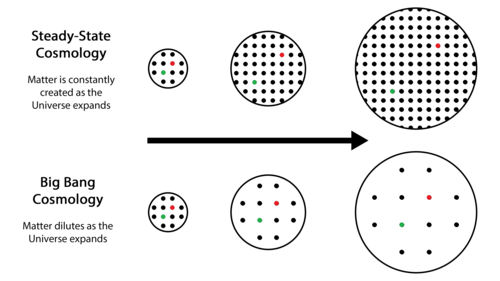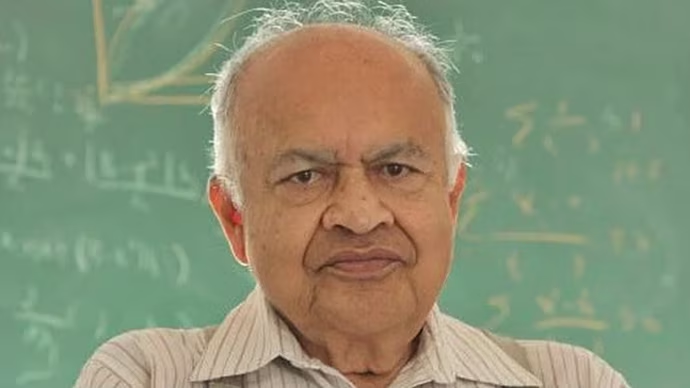Facts for UPSC Mains
Quasi-steady State Cosmology Theory
- 22 May 2025
- 9 min read
Why in News?
Renowned astrophysicist and one of India’s most influential scientists, Professor Jayant Vishnu Narlikar, passed away in Pune. He was best known globally for his pioneering work on the quasi-steady state cosmology theory of the universe.
What is the Quasi-steady State Cosmology Theory of the Universe?
- About: The Quasi-Steady State Cosmology (QSSC) is a refined version of the Steady-State Theory of the universe. It was developed in the early 1990s by Fred Hoyle, Jayant Narlikar, and Geoffrey Burbidge as a response to the increasing dominance of the Big Bang theory, while addressing some of its limitations.
- Key Features of QSSC:
- Combines Steady-state and Cyclic Concepts: QSSC proposes that the universe follows a cyclical pattern of periodic expansion and contraction over vast timescales, while still maintaining an overall steady-state appearance.
- No Singular Origin: While the Big Bang theory posits a singular origin of the universe, QSSC rejects the idea of a singular explosive beginning.
- Instead, it suggests that the universe has existed eternally and undergoes periodic episodes of matter creation and expansion.
- Matter is continuously created in localized, non-singular events called ‘mini-bangs’ or creation events, which occur intermittently in the universe, avoiding a single origin point.
- Modified General Relativity: The theory introduces modifications to Einstein’s equations of general relativity to account for continuous matter creation, a key contribution by Jayant Narlikar.
- Scientific Acceptance: QSSC considered a minority alternative to the Big Bang, with some mathematical innovations, but not widely accepted in mainstream cosmology.
Note: The steady-state theory, proposed in 1948 by Hermann Bondi, Thomas Gold, and Fred Hoyle, posits that the universe is eternally expanding while maintaining a constant average density.
What is Big Bang Theory?
- About: The Big Bang Theory, proposed in 1927 by Belgian cosmologist Georges Lemaître, explains the origin and evolution of the universe, proposing that it began around 13.7 billion years ago from an extremely hot, dense point known as a singularity.
- The evolution of the universe started with a phase of cosmic inflation (an incredibly rapid expansion that occurred within a fraction of a second after the Big Bang).
- As the universe expanded and cooled, energy converted into fundamental particles, forming matter and radiation. This led to the creation of atoms, stars, galaxies, and planets, along with the emergence of the four fundamental forces: gravity, electromagnetism, strong nuclear, and weak nuclear forces.
- Planck Epoch: The Planck Epoch is the first 10⁻⁴³ seconds after the Big Bang, when the universe was extremely hot and dense. Current physics (General Relativity and Quantum Mechanics) cannot describe this period, and a theory of quantum gravity is needed to understand it.
- Evidence Supporting Big Bang:
- Edwin Hubble's observations, famously known as Hubble's Law, showed that galaxies are moving away from each other, with farther galaxies receding faster, indicating the universe is expanding.
- The Cosmic Microwave Background (CMB) radiation, discovered by Penzias and Wilson, is the cooled leftover radiation from the first light that traveled freely through the Universe shortly after the Big Bang.
- It is considered a fossil or echo of the Big Bang, this ancient light has since cooled and weakened and is now detected as microwaves.
- The European Space Agency’s Planck mission observed this oldest detectable radiation, providing valuable insights into the Universe’s origin and evolution.
Who was Dr. Jayant Vishnu Narlikar?
- Early Life: Born on 19th July 1938 in Kolhapur, Maharashtra, Dr. Jayant Vishnu Narlikar pursued higher studies at Cambridge University.
- Institutional Building: In 1988, he was invited by the University Grants Commission (UGC) to establish the Inter-University Centre for Astronomy and Astrophysics (IUCAA) in Pune as its Founder Director. His leadership made IUCAA a global science hub.
- Bibliography: Dr. Narlikar was also a noted science communicator and author of popular science fiction works, including An Introduction to Cosmology.
- His autobiography, A Tale of Four Cities (Char Nagaratale Majhe Vishva), was awarded the Sahitya Akademi Award in 2014 for its literary merit in Marathi.
- Awards: Received Padma Bhushan (1965) and Padma Vibhushan (2004). In 1996, Narlikar received the UNESCO Kalinga Prize for his exceptional work in popularizing science.
- Additionally, in 2011, he was conferred the Maharashtra Bhushan, the highest civilian honor awarded by the Government of Maharashtra.
| Read more: Challenging Big Bang Theory |
|
Drishti Mains Question: Differentiate between the Big Bang Theory and the Quasi-Steady State Cosmology in explaining the origin and evolution of the Universe. |
UPSC Civil Services Examination, Previous Year Question (PYQ)
Prelims:
Q.The terms ‘Event Horizon’, ‘Singularity’, ‘String Theory’ and ‘Standard Model’ are sometimes seen in the news in the context of (2017)
(a) Observation and understanding of the Universe
(b) Study of the solar and the lunar eclipses
(c) Placing satellites in the orbit of the Earth
(d) Origin and evolution of living organisms on the Earth
Ans: (a)
Q. Which of the following is/are cited by the scientists as evidence/evidences for the continued expansion of universe? (2012)
- Detection of microwaves in space
- Observation of redshift phenomenon in space
- Movement of asteroids in space
- Occurrence of supernova explosions in space
Select the correct answer using the codes given below:
(a) 1 and 2
(b) 2 only
(c) 1, 3 and 4
(d) None of the above can be cited as evidence
Ans: (a)
Q. Which of the following pairs is/are correctly matched? (2008)
Theory/Law Associated Scientist
- Continental Drift : Edwin Hubble
- Expansion of Universe : Alfred Wegener
- Photoelectric Effect : Albert Einstein
Select the correct answer using the code given below:
Code:
(a) 2 and 3 only
(b) 3 only
(c) 2 only
(d) 1 only
Ans: (b)








